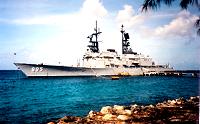When a plane was spotted taking off from a know drug location it was tracked and its location was given over the US Air force. Fighter aircraft would actually approach these planes and follow them toward their drop off point. Most of the time the plane would circle a spot in the ocean and if a fighter was present return to Columbia with its cargo. Other times the fighter would radio the location to Coast Guard ships and allow the plane to drop its load of drugs. Then the Coasties would stop the boat and get the drugs. These types of operations netted a small amount of drugs and would pretty much cause slight problems with the drug runners.
What would cause them a major head ache was when the Navy would track and stop one of their large shipments. These were sent onboard a freighter. When were did our tour on the drug line we did both searches, airborne and surface. We also carried a group of Coast Guard people. The Navy cannot legally stop ships on the seas, but the Coast Guard can. So when a suspected drug ship was spotted we would raise the Coast Guard ensign and the Coast Guard would take command of the ship and stop the freighter.
Our tour was six weeks long off the coast of Columbia. We had a certain area of operation to patrol over that time frame. We stopped several different ships and searched them for drugs, but turned up nothing. We also sent fighters to follow several different aircraft, these were called soft kills because no drugs made it past. But, we wanted to get a hard kill. We received word from the DEA there would be a freighter coming out with 3500 kilos of pure cocaine. We knew where it would leave form and where it was going to, but not when.
While we were operating in this area we also were getting ready for a major engineering inspection, or OPEE (Operational Propulsion Engineering Exam). So we practiced fire drills, engineering drills, and rewrote 2 years worth of engineering logs. We then got a call about a freighter coming out with between 2500 and 3000 kilos on board. We chased her down and waited for the go ahead from the admiral. He then told us to return to our patrol area and wait for our sting to go down. His ship would stop the other ship. By the time that ship was stopped they had more than likely thrown everything over board and cleaned down their hold. The big evidence to this was the fact they used fresh water to clean out the hold with.
A few days later we got our chance, the sting was on. The freighter left port with its 3500 kilos of cocaine and sailed right into our trap. We stopped her and found her secret cargo. Since the sting had taken a few days to set up another Navy ship in the area came along with us to take the drugs to Puerto Rico. Our board team had to carry each bundle of drugs to the waiting boat and then take it to the waiting ship. There were just over 3500 kilos on board and we actually had one of the largest drug busts in that area, ever. However since it was a sting from the DEA we could not mention it at the time because they did not want to endanger the source. This was a little disappointing because we did not get to mark the kill on our bridge wing like normal.
A few days later we came across a small “fishing” boat that was drifting out to sea. They had run out of gas and were at the mercy of the sea. The Coast Guard went aboard and found several bits of evidence that pointed to their real purpose, drug running. But there was no direct proof the small boat was actually running drugs. They found expensive triple beam scales, cases of Ziploc baggies, and the boat had two brand new outboard motors. The boat was in rotten shape, but those two new motors stuck out like a sore thumb.
With no drugs on board we gave them some gas, something to eat, and pointed them back to land. They probably made it back about 4 hours later and then returned the next day to do more drug cutting and transferring. The sad thing about that one is we were given a Humanitarian Medal for rendering aid to them.
We were released from our patrol and headed to Barbados for 3 days of liberty. I had my first Red Stripe beer there and way too many rum drinks. We then made a high speed run from Barbados to Mayport Naval Station in Florida. Our captain decided he wanted us to get into port a day ahead of schedule so he stomped on the gas pedal. With us running at flank 3, about 33 knots, and running all three generators we were gulping fuel at the rate of 1.4 gallons per second. We could almost sit in the control room and watch the service tanks gages go down during our watch.
At the end of our operation we had one hard kill of over 3500 kilos and over 50 soft kills. We did our part to work at stem the drug flow in the US.
This is the Scott while were in Barbados. We were at a little bar on the beach just down from the pier when i took this. Ice cold Red Stripe for $1.00.















